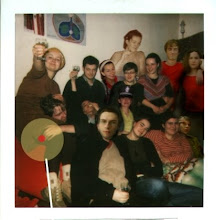
GABRIELE SENN galerie
curated by_Roberto Ohrt
DIE UNSICHTBAREN VIER | THE INVISIBLE FOUR
Dorota Jurczak | Tomasz Kowalski | Philipp Schwalb | Strupek Group
Eröffnung | Opening: 12.5.2011, 18 Uhr | 6 pm
Dauer | Duration: 13.5.2011 - 18.6.2011
Strupek Group - Microart 1:10
A N I M A L I A
curator Wojciech Szymański
Irena Kalicka | Aleksandra Lewandowska | Mateusz Okoński | Marta Sala
ANIMALIA, Whomus Nature
Animalia is a presentation of the work by four artists: photographs by Irena Kalicka, drawings by Aleksandra Lewandowska, paintings by Marta Sala, and Mateusz Okonski’s site specific work displayed as photography. All works, although made in different media, address an interesting problem of an unique relationship between humans and animals. All the works can be read in reference to the title of the exhibition, Animalia, a notion making us think of bestiality and natural impulses, wildness contained in a word animal on the one hand, and rational and cultural element of the Latin word anima (soul) on the other hand.
This ambiguous tension has been used by Aleksandra Lewandowska, who addresses the relation between culture and nature by drawing a silhouette of a cross between a man and a horse. This is not, however, a conventional Centaur known from the Greek myths, a half-man and a half-horse having vitality and sex of animal and head and reason belonging to human. A borderline between an animal and a human has not been crystallized here, and a mythological beast, savage yet rational, gains a new unfamiliar shape.
A touch of bestiality characterizes also Marta Sala’s painting. However, it is not about bestiality understood as cruelty towards animals. A fat, stocky, decapitated girl strangling a cat is not bestial doing this. Bestiality of that and other works seems to be something completely different. Bestiality means a practice of carrying exoticism to the extreme. This is a kind of bestiality that seeks ecstasy from the contact with a creature which can never be fully comprehended. Hence, this is not the cat’s agony that works as bestiality here, but the fat girl without the head herself. It is her, with her half-black and half-flesh-coloured body, who is a beast situated between nature and culture, between self-understanding and self-misunderstanding. She is a mermaid from Andersen’s fairy tale, a mermaid deprived of human voice. She lost her human nature and subjectivity by the act of decapitation.
Several models participating in a non-normative orgy from Irena Kalicka’s photos do not have heads and faces either. A symbolic act of decapitation is analogous to an act of putting on animal masks. This is necessary here because bestiality as an attempt to cross human barriers and touch impossibility is a taboo sphere and needs a mask. It is thanks to a mask only, both a literal and a symbolic one, by means of which we should read Irena Kalicka’s photographical games with European painting tradition: her references to Pompeian Villa dei Misteri frescoes and allusions to Three Graces motif, that the impossible crossing of human nature seems to be almost attainable.
Ecstasy, the process of transgressing one’s own self, remains merely a dream which, by means of transgressing nature, tries to trans-humanize itself.
Wojciech Szymanski




























